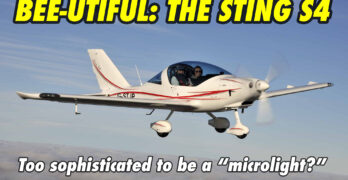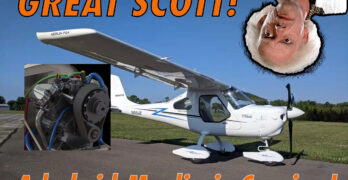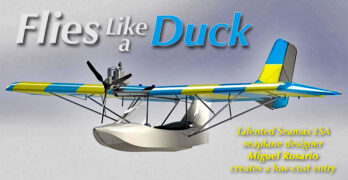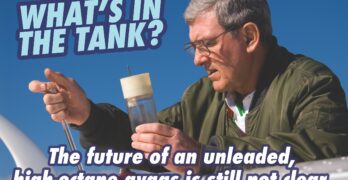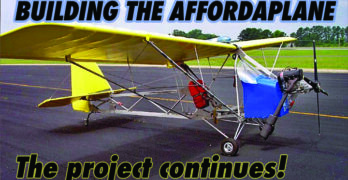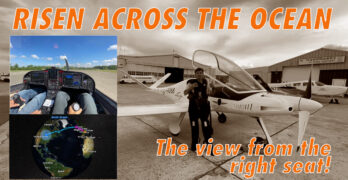“Look at that groundspeed!” I exclaimed, pointing at the Garmin EFIS. “Our TAS is nearly 125 knots, which means we’ve got a 60 knot headwind straight on the spinner!” “Can you imagine being up here in a traditional microlight?” asked the Sting’s owner, John Palmer. “No, because not only would I be scared out of my mind at the prospect of having to land, but right now we’d practically be going backwards!” I said.
I’ve written before about just how capable and potent the new breed of light sport microlights is, and several of the aircraft I’ve tested recently are not only comparable to traditional GA types, but are demonstrably superior. An excellent representative of this new breed of speedy sport planes is the Sting S4, from Czech airframer TL Ultralights.
As I wait at Saltby for John to arrive in the Sting, I’m aware that it’s extremely windy, and that if I’d told someone that I was planning on flying a microlight in such conditions, they’d probably think I was mad—or suicidal.
Look Out — A Hybrid Merlin is Coming!
First introduced in Europe in 2013, the all aluminum single seat enclosed cabin Merlin LSA has sported a variety of engines, including a Rotax 582, a specially built four stroke V-twin and even an electric motor. In fact, the Merlin airframe has served as a test bed for all kinds of propulsion and aerodynamic innovations. At AirVenture 2023, Aeromarine chief designer Chip Erwin even showcased a Merlin model with twin propellors imbedded in the wings. Erwin promises an even bigger surprise at Oshkosh later this month: a common-sense hybrid propulsion system for the Merlin.
Erwin, who has done work for the Air Force Research Lab in Dayton, Ohio, has developed a parallel hybrid drive system for light sport aircraft that utilizes an electric motor to add to thrust generated by a
piston engine during takeoff and climb, but shuts down during cruise. He points out that a major limitation of all electric aircraft is the need to lug around a heavy battery capable of providing thrust for a limited period of time.
If It Flies Like a Duck and Floats Like a Duck, Maybe It IS a Duck
Article Updated July 17, 2024 — After this article was posted, Miguel Rosario reported, “Duck is still in tests. Now we will install a 912 ULS 80-horsepower engine, as requested by future customers.” He continued, “Molds are under construction for production, which we hope to start in three months” (approximately October 1, 2024). He finished, “I will keep you updated on all developments regarding Duck.” —DJ
You probably know Seamax. This longtime, performance-oriented LSA seaplane was one of the first to make a splash in the U.S. light aircraft market way back in December, 2007.
Today, regretfully, the Seamax company is going through some very difficult circumstances as noted in this State of the Seaplane Sector report. We don’t know the end of those stories yet.
Nonetheless, Seamax M-22 designer Miguel Rosario remains active. You can’t keep a good man down but apparently you can keep him on the water.
Paths to Affordability
It’s become almost folklore. The quest for affordability in the world of general aviation has been like trying to see the aurora on a cloudy night, or recalling a dog set loose on a squirrel in the forest, or even encountering Bigfoot. From the crash of the post-WW-II airplane buying frenzy, to the mid-1980s liability-fueled dissolution of the general aviation manufacturing industry, to the relative lack of affordability following what the introduction of LSA promised to be, we’re still here, waiting for a real solution.
Parallel paths toward increased affordability exist. One is hopeful and one is tangible.
On the hopeful side we have MOSAIC, which promises to increase capability and affordability within the LSA category by expanding Sport Pilot privileges and making a range of aircraft available to pilots limited to those privileges. Moreover, the MOSAIC-style LSAs could get a lot heavier and faster and more capable—including potential use at night and in instrument conditions.
Gas Pains — The Latest Mayhem Surrounding a High-Octane Avgas Replacement
The ongoing issue of finding a replacement for leaded avgas took an ugly turn recently after Cirrus advised owners that use of anything other than an “approved” fuel would likely invalidate the engine warranty. “Per Continental and Lycoming, only approved fuels may be used for an engine to be covered by warranty. As the GAMI G100UL fuel is a non-approved fuel per Continental and Lycoming, engines known to have run this fuel may not be covered by the OEM engine warranty. For specific details, please refer to the respective Continental and Lycoming engine warranty documents,” Cirrus said in a statement. “While some aspects of the initial Cirrus testing of the GAMI G100UL fuel are encouraging, other areas, including materials compatibility, remain inconclusive.”
At issue is that the GAMI fuel has not been submitted to the ASTM for “approval” but has received FAA approval in the form of a Supplemental Type Certificate that applies to virtually every spark-ignition aviation engine made.
Building the Affordaplane, Part 3
In the previous installment, I described construction details for the fuselage section of the Affordaplane ultralight project. Now let’s look at construction of the empennage and wing assemblies. Remember, this is a plans-only type of build using off-the-shelf materials and tools intended for a novice builder. Keep this objective in mind when reviewing the construction and design details. A complete free video series on YouTube shows each step of this construction.
The components of the empennage (rudder, elevator, vertical and horizontal stabilizers) are all formed from 1-inch 6061-T6 aluminum tubing. These tubes must be bent into their respective shapes, matching template patterns drawn on your workbench. (Use some craft paper for this!) What is the easiest way to form these simple bends? I found that using an electrician’s conduit bender did the job nicely. With a little practice, each tube was formed to the proper shape and then fitted with a gusset to join its ends.
Inside the Transatlantic Crossing of the Risen
We recently reported that the newest version of the sleek, retractable-gear Risen had made a successful transatlantic crossing. From what we could piece together from outside accounts and posts on social media, it went well. But here’s a more first-person look at the crossing, from the perspective of the right seat.
Andrea Venturini accompanied designer Alberto Porto on the epic journey across the pond. Here’s his account.
It all started last December, with a phone call I received from Alberto Porto. At the time, I was in Australia doing a report at the Gliding World Championship for theItalianTeam. Onthephone Alberto, designer and builder of the fastest ultralight in the world (430 kph/232 knots), with the simplicity that always distinguishes him, says: ”Andrea, keep yourself free for next June, I’ll detail everything when you return to Italy.”
You can imagine my curiosity in the meantime. A few weeks later, the mystery was revealed: the Risen Superveloce with the brand new Rotax 916 iS must be brought to Oshkosh, to AirVenture, the largest and the most important aviation fair ‘of the Universe.’ I knew well what Oshkosh meant.
Advanced Degree in Rotax-erie
Editor’s Note: This story originally appeared in KITPLANES magazine but since so much of the LSA world depends on Rotax engines, we thought this was worth a read here.
Thirteen years into my two-year SeaRey build, OspRey finally had its engine mounted. But when I signed on the dotted line for my new Rotax 914, and with little more knowledge than how to change the oil in my car, I was nervous about my abilities to maintain this expensive engine. Because of this, back in 2014, I attended a weeklong service and maintenance class at Canadian Rotax distributor Rotech Motor, Ltd. Thanks to an excellent hands-on instructor, who acted like he had all the time in the world and a bagful of instructor tricks to teach us, by the second afternoon I had dropped my skepticism and distrust of the price/power ratio of the Rotax engine and was (almost) ready to go out and get a Rotax tattoo.
Buying Used: Flight Design CTs
If you’ve ever shopped for a used sport plane you’ve probably noticed there are almost always a number of Flight Design CT series LSAs up for sale. This shouldn’t be surprising since Flight Design was an early player in our segment of aviation, and in the past two-plus decades the company has sold more than 400 CTs in the U.S. alone.
The planes have proven popular, in part, due to their speed (for an LSA), having a cabin wider than a Cessna 172 and their generous payloads. This article is an introduction to the various CT models, their flight characteristics, and advice for a pre-buy inspection and ownership.
Development
The first CT was produced in Germany by a company that began with hang gliders and paragliders in the 1980s and ultralights in the early 1990s. Now part of LIFT Air Gmbh, Flight Design has faced financial woes over the years, having gone into receivership, and then challenges caused by the war in Ukraine where the aircraft were being built.
MOSAIC – A Different Perspective
A lot has been written about the contents of the MOSAIC NPRM and many people and organizations have been able to comment on it to the FAA. Much of the commentary has been around the extension, or in some cases, curtailing of existing privileges for Sport Pilots, aircraft that can fit into the Light Sport definition and Light Sport Repairman certifications. I don’t plan to re-hash any of that here. This article will focus on what some of these changes could mean, in practical terms, to the market for Light Sport Aircraft and its customers. As you will see, it has the potential to be highly disruptive which not everyone will be happy about but will do so in a way that also opens up opportunities to a wider audience.
Before delving any deeper, let’s dispel the myth held by some in general aviation that Light Sport has been a “failure”.
- « Previous Page
- 1
- 2
- 3
- 4
- …
- 22
- Next Page »


